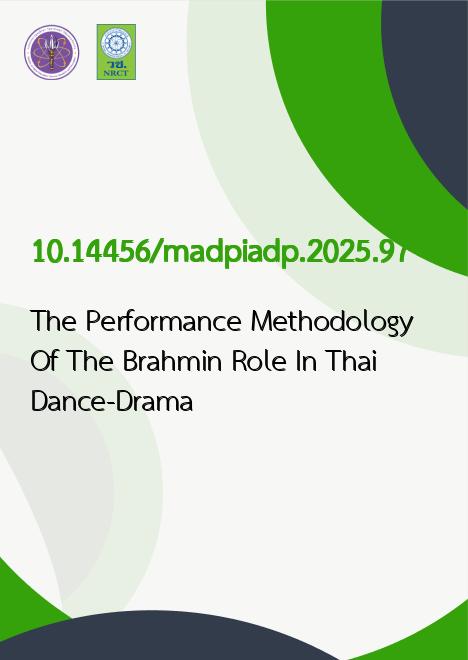
|
The Performance Methodology Of The Brahmin Role In Thai Dance-Drama |
|---|---|
| รหัสดีโอไอ | |
| Creator | Kanpavi Krasaesan |
| Title | The Performance Methodology Of The Brahmin Role In Thai Dance-Drama |
| Contributor | Supachai Chansuwan, Chanai Wannalee |
| Publisher | DR.KET Institute of Academic Development and Promotion |
| Publication Year | 2568 |
| Journal Title | Modern Academic Development and Promotion Journal |
| Journal Vol. | 3 |
| Journal No. | 2 |
| Page no. | 1281-1297 |
| Keyword | Performance Methods, Brahmin, Thai Dance-Drama |
| URL Website | https://so12.tci-thaijo.org/index.php/MADPIADP/ |
| Website title | https://so12.tci-thaijo.org/index.php/MADPIADP/ |
| ISSN | 2822-1095 |
| Abstract | Research paper on, titled "Performance Methods of Brahmin Characters in Thai Dance-Drama," aimed to: 1. investigate the roles of Brahmin This research aims to explore the dance methods of Brahmin characters in Thai classical drama, focusing on two specific figures: Brahmin Sri-ket (Phra Lor in disguise) in Lakhon Phanthang and Brahmin Ketsuriyong (Lady Ketsuriyong in disguise) in Lakhon Nok. Use the triangulation verification method.The objectives of the study are: (1) to investigate the dramatic roles of Brahmin Sri-ket and Brahmin Ketsuriyong within their respective dramatic contexts, and (2) to analyze the dance techniques and movement characteristics associated with these characters. This qualitative research utilizes document analysis, review of related studies, and field data collection.The findings reveal that Brahmin Sri-ket, in the garden scene of Lakhon Phanthang, employs a strategic concealment of identity under a respected persona, reflecting a narrative technique of disguise and deception. Conversely, in Lakhon Nok, Brahmin Ketsuriyong’s role in the cave admiration scene demonstrates a concealment of gender identity in response to romantic advances. The analysis of their respective dance forms indicates distinct movement aesthetics rooted in the stylistic differences between Lakhon Phanthang, which integrates expressive and narrative gestures (ram-ok-phasa), and the more codified royal-style choreography of Lakhon Nok. The study highlights how dramatic context influences character movement, expression, and the embodiment of identity through dance. |